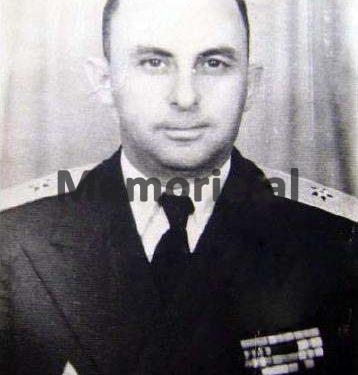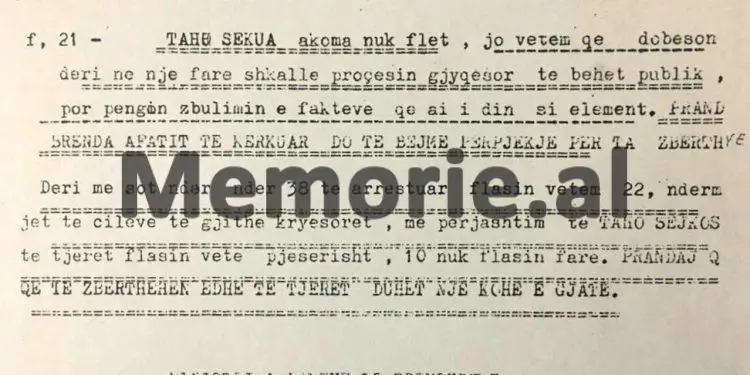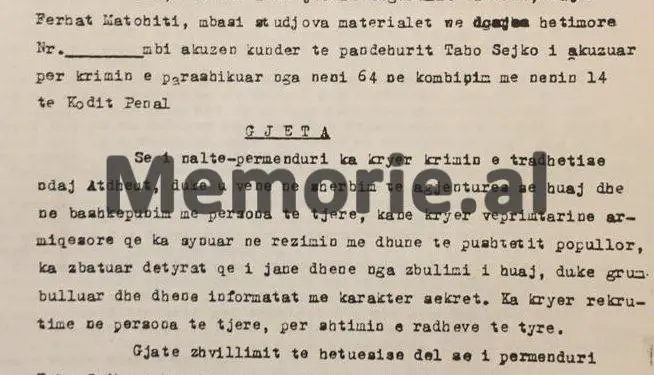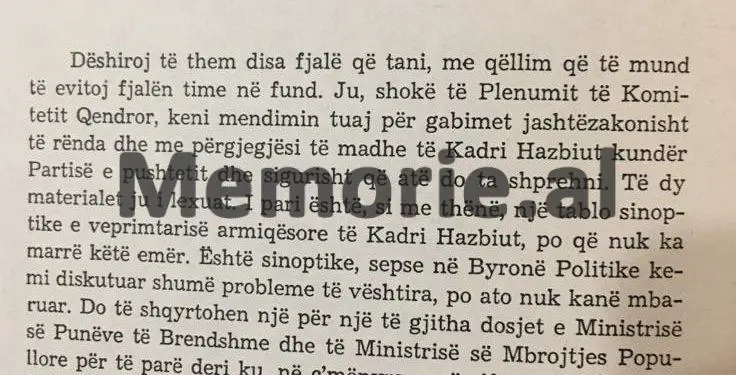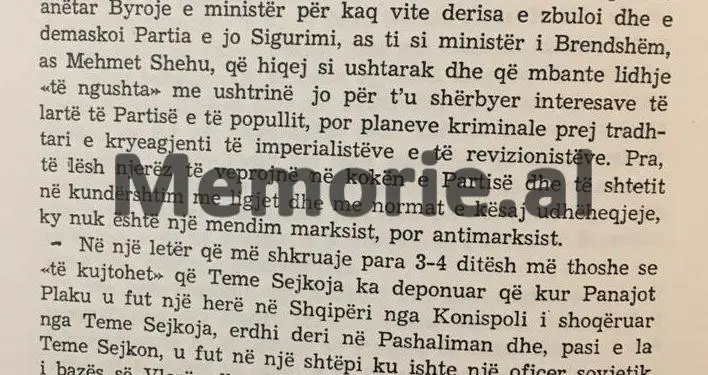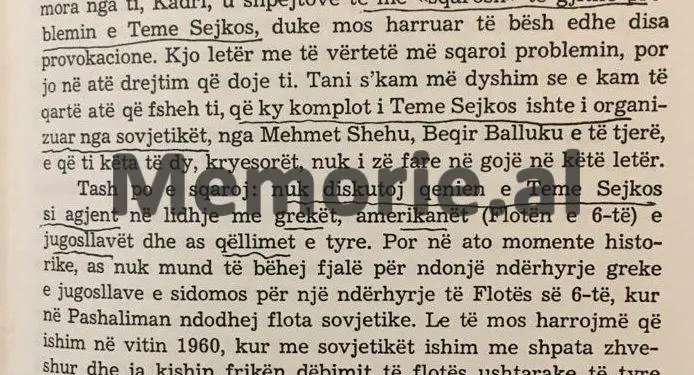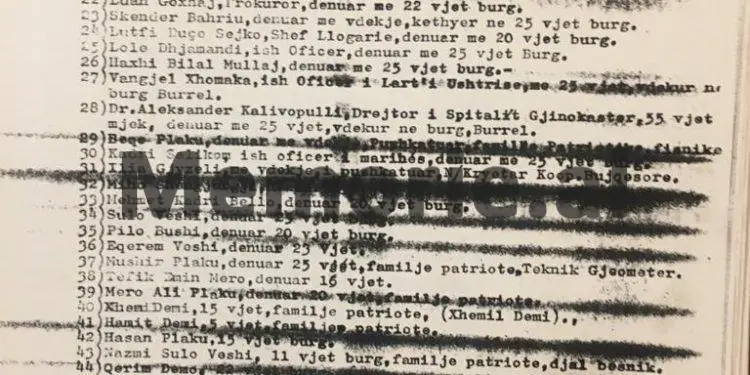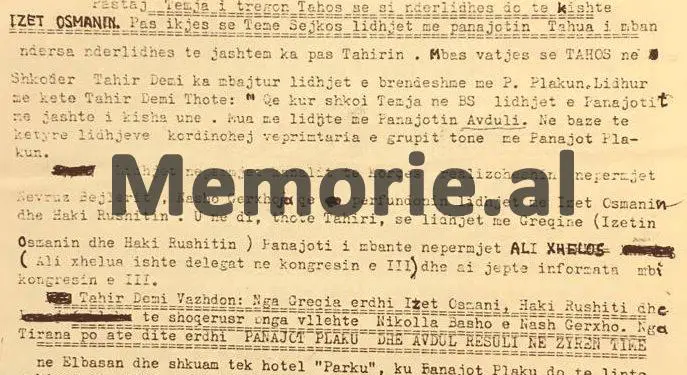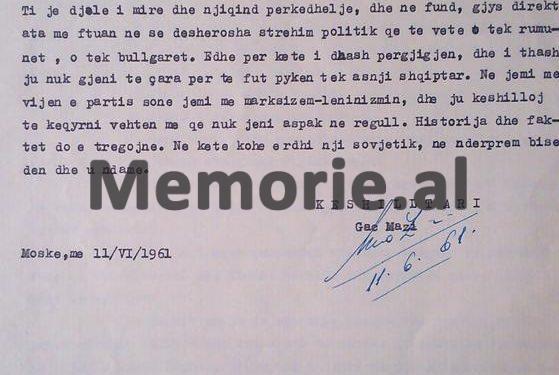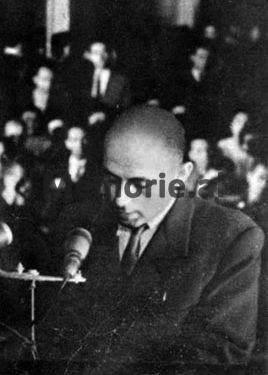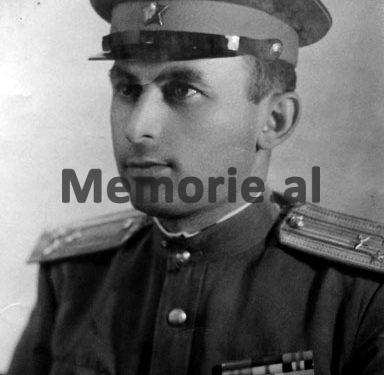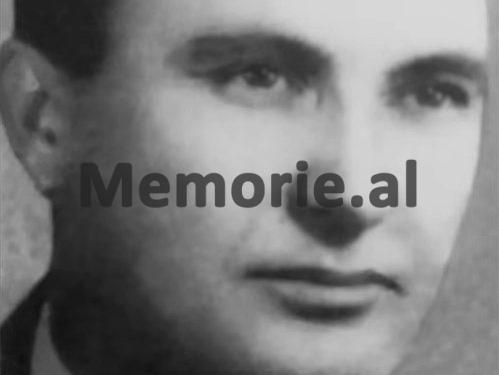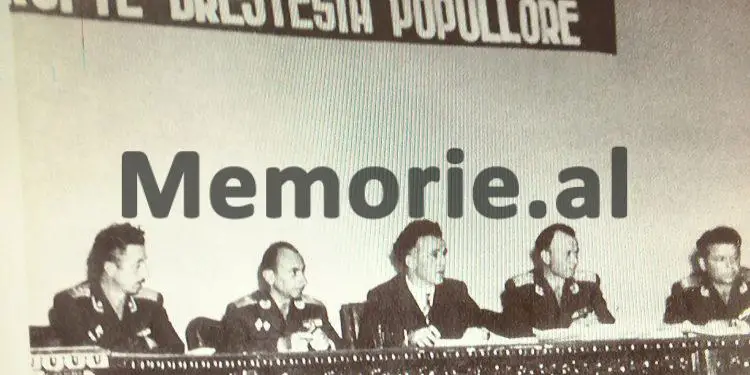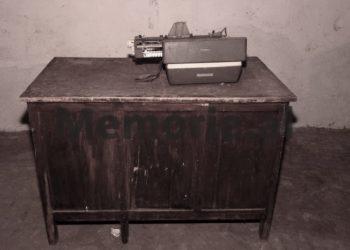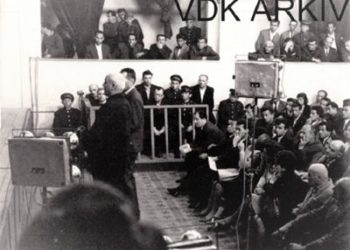Dashnor Kaloçi
Memorie.al publishes events, facts, testimonies and unknown documents, from the history of the so-called “Cham conspiratorial group” which was instigated by Kadri Hazbiu at the suggestion of Soviet advisers and approved by Enver Hoxha, who in the IV- Congress of the ALP, on 13 February 1961, three months before the trial against them, stated: “I can declare to the Congress, the people of the Party, that these two neighboring powers, Yugoslavia and Greece, in cooperation with some traitors within fugitives in Yugoslavia, and in cooperation with the US 6th Fleet in the Mediterranean, had organized a plot against Albania a few months ago, which aimed to liquidate the Republic of Albania, but which failed miserably and the conspirators of the facts are in the hands of popular justice ”. While on October 13, 1982, at the Plenum where Kadri Hazbiu was being beaten, Enver said: “After we were preparing the attack for the Meeting of the Communist Workers’ Parties in Moscow, they threatened us, but seeing our determination they organized with their agency, Mehmet Shehu and company, the so-called conspiracy of Teme Sejko that our country would allegedly be attacked by the US Sixth Fleet with the support of the Yugoslavs and Greeks. In other words, the Soviets were telling us: “Do not make a joke to remove our military base from Pashaliman, because the attack is ready to destroy Albania and you need us.”
In the last two parts of this article published by Memorie.al we got acquainted with the history of how and why the “Cham Conspiratorial Group” was staged, the development of the investigation process against Taho Sejko and also the conduct of the trial against the “Cham Conspiracy” led by, Rear Admiral of the Navy, Major General, Teme Sejkos. During the investigation process against the Cham group, which was accused of “links with the agencies of some western countries, in order to overthrow the popular power in Albania”, various tortures were used against the detainees who did not accept the charges. One of those arrested who was not broken by the pressure and torture inflicted on the Investigator was Taho Sejko, who along with his brother, Temen, were considered the head of the hostile group. Lt. Col. Stavri Madhi, of the Tirana State Security Directorate, was initially appointed as Tahos investigator, but after failing to force him to sign the indictment, he was removed and replaced by appointed Ferhat Matohiti. But even Matohit could not dismantle Taho, who could not stand the torture, fell on the wall of the cell with his head, losing his memory forever. As a result, Taho was the only one who did not appear in the trial of the “Cham Conspirators” and in the report that Kadri Hazbiu sent to Enver Hoxha, he wrote that: “Taho’s failure to appear in court, jeopardized the submission of the investigation process in due time and would also weaken in some way the judicial process”. Shortly before the end of the investigation process, without any motivation, he was dismissed from the post of Deputy Chief Justice of the Supreme Court, Lieutenant Colonel Mustafa Qilimi, whom Rita Marko pressured to arrest, saying that he was a friend of Tahir Demi. The trial of the “Cham Conspirators” began on May 18, 1961 in the Cinema Hall of the Brigades and was led by the President of the Supreme Court, Shuaip Panariti and its members were: Major General Muharrem Kokomani, Colonel Bejto Isufi, Colonel Sotir Spiro and Hilmi Telegraph.
follows from the previous number
Punishment of “Cham conspirators” and their consequences
On Sunday, May 18, 1961, following the claim of the General Prosecutor of the Republic, Arianit Çela, the President of the Court, Shuaip Panariti, who was also the President of the Supreme Court, announced the decision, giving the respective sentences to the 38 defendants. of that sensational process. Teme Sejko, Tahir Demi, Avdul Resuli and Hajri Mane, were sentenced to death, by firing squad, being considered the head of the conspiracy. While six other defendants, who came after them in terms of importance and role they had played in the “plot”, who were mainly from the villages of the border area of Saranda and Konispol, ranchers and beekeepers, were sentenced to 20 to 25 years. jail. Similarly, the rest of that large group of “Cham conspirators” were sentenced to several years less in prison, where most of them died in camps and prisons, being physically eliminated.
While Kosta Fili, who accepted the game of State Security claiming that he was an agent of Greek intelligence and their liaison with Teme Sejko Group, suffered 25 years in the camps and prisons of the communist regime of Enver Hoxha, without obtaining any amnesty or forgiveness. He was released from Burrell Prison in 1986 and, after being held in solitary confinement for six days in the Hotel-Tourism of that city, was provided with a passport by the Security and sent to Greece, ostensibly as a repatriate. His departure for Greece, the Security made because the further stay in Albania, would create problems, unmasking or deconstructing to some extent the process of “Cham Conspirators”, as Kosta Fili was an unfortunate with health problems mental, and after his release from prison, many who would come in contact with him would understand very well what agent or liaison he had been.
Statement by Haki Rrushiti from the USA: I have not moved a single day from the country
Kosta Fili lived until a few years ago somewhere in one of the suburbs of the city of Ioannina and after the ’90s he had refused any meeting with Albanian citizens and also his Greek compatriots, he never gave a correct answer regarding the reasons why in Albania they kept him in prisons for a quarter of a century?! One of the defendants in that trial, as “the liaison of the conspirators with the Greek and American secret services and with Panajot the Elder, was Haki Rushiti”, who lived in the USA Rrushiti had fled to Greece since the time of the War, having been the commander of the first partisan detachment in the province of Chameria, and later crossed with the nationalist forces of the National Front. Accused in court as an agent of some secret services, on June 6, 1961, Haki Rrushiti made a statement in the Albanian press of New York, where among other things he stated: “During the trial I was also accused as an agent of Greece and of the secret services of the US 6th Fleet, that I allegedly had contacts with the Cham prisoners as they were. I came to the US on December 25, 1955 and since then I have not left this country for a single day. This is well known to the communist delegation (embassy) located here in New York, which is certainly informed day by day about the activity of Albanians and anti-communist diaspora by their agents who see me day by day.
How was the murder of Taho Sejko disguised by the Supreme Court?
The Sejko family had a very tragic end, of which there were five victims. After the trial of the “Cham Conspirators” in the direction of the Politburo, many anonymous letters were made asking why Taho Sejko was declared an enemy and did not appear in court. The Supreme Court of the People’s Republic of Albania, after that made a press statement (the only case) announcing that “Taho Sejko appeared in court, was sentenced to death and executed.” No trial has taken place for Taho, and this fabrication of the communist regime of that time, quoted by the Supreme Court, was merely an excuse to camouflage the inhuman tortures used against him in the Security and Investigation cells. who, after suffering a brain injury, turned out to have been held for many years in psychiatric hospitals, isolated as a laboratory cell, where students and forensic specialists performed trials and lessons.
His wife Irfane Sejko (Mane) before the ’90s did not leave the place without asking and the state office without knocking, but never got any correct answer. Likewise, their son, Hektor Sejko, did the same after the ’90s, but even today there is no information what was the fate of his father?! For both Taho and Temen, in the Archives of the Ministry of Internal Affairs, there is no execution documentation and burial site. After the sentencing of Tahos and Temes, their third brother, Sulo Sejko, who lived in Shkodra, due to the great pressures from certain state segments and the close family environment where he lived, initially tried to wait. veins and then committed suicide by jumping into the well.
Teme Sejko’s family was interned in the city of Berat, where in 1974, his son, Sokoli, (23 years old) was sentenced to death by firing squad, accusing him of: “wanted to blow up the Textile Factory in Berat”. The day we were his, (Teme’s wife) Shpresa, was informed of her son’s execution, she committed suicide by jumping from the fifth floor of the apartment where she lived. But the tragedy of this family did not end there, because on the day that Shpresa Sejko committed suicide, her son, Raimond Sejko, was arrested, accusing him of “pushing his mother and throwing her from the fifth floor.” After that, he was brought to trial and sentenced to 15 years in prison, also charged because he had not denounced his mother, who allegedly distributed leaflets the day his brother, Sokol, was executed.
Enver in ’82: “Cham plot”, work of Kadri Hazbiu
Regarding the “Conspiracy of the Cham group” by Teme Sejko, in all the speeches given by Enver Hoxha, for 20 years, he has been very contradictory. Thus, in the fourth Congress of the ALP, on February 13, 1961, three months before the trial against them, he said, among other things: “I can declare to the Congress, the people of the Party, that these two neighboring powers, Yugoslavia and Greece, in cooperation with some traitors inside the country and fled to Yugoslavia, and in cooperation with the 6th US Fleet in the Mediterranean, had organized a few months ago the conspiracy against Albania, which aimed to liquidate the Republic of Albania, but it failed completely and the conspirators and the facts are in the hands of popular justice ”. This word of Enver Hoxha is filmed by the former Kinostudio “Shqipëria e Re” and it was broadcast after the ’90s by several television channels in various shows. Contrary to what he had spoken at the IV Congress of the ALP, at the meeting of the Plenum of the Central Committee of the ALP held on November 8, 1982, when Enver Hoxha was crucifying Kadri Hazbiu, among other things he was says: “The case of Teme Sejko is full of mystery. In the synoptic picture of the agent activity of the enemy Mehmet Shehu, I said that I am not clear about the plot of Teme Sejko and what role Mehmet Shehu played in it. We were told that this was a plot organized by the Greek-American and Yugoslav agencies linked to the 6th American Fleet in the Mediterranean. When we spoke in the Fourth Congress about this conspiracy, the Soviets pretended to be alarmed, and even Gomulka proposed that they send us a commission from the Warsaw Pact, which we rejected. In the letter you sent me, Kadri, you hurried to explain the problem of Teme Sejko to me, trying to make provocations as well. This letter really clarified the problem for me, but not in the direction you wanted. Now I have clear what you are hiding. This plot of Teme Sejko was organized by the Soviets, by Mehmet Shehu, etc., that Kadri does not mention at all in this letter. After we were preparing the attack for the Meeting of the Communist Workers’ Parties in Moscow, they threatened us, but seeing our determination they organized with their agency, Mehmet Shehu and company, the so-called plot of Teme Sejko that our country would allegedly be attacked by 6th American Fleet with the support of the Greeks and Yugoslavs. In other words, the Soviets were telling us: “Do not make a joke to remove our military base from Pashaliman, because the attack is ready to destroy Albania and you need us.”
With these words he addressed Enver Hoxha, the former Minister of Interior, Kadri Hazbiu, in the Plenum of the Central Committee of November 8, 1982, where at the end of his speech, Enver said: “And yet, they were enemies.” This is how Enver Hoxha appeared regarding the approval he had given years ago for the strike of the “Teme Sejko Group”, speaking at the Plenum which he had gathered specifically to strike Kadri Hazbiu, one of the people who had used him physically eliminated all his opponents since 1954 when he put him in the post of Minister of the Interior, which he no longer needed!
“Cham plot”, in continuation of those of Eastern Europe
The words of Enver Hoxha said in the direction of Kadri Hazbiu, seem to constitute the real version of the so-called “Conspiracy of Teme Sejko”. That fabricated plot was another fabrication in the course of what was staged in most of the communist countries of Eastern Europe after World War II, identical to those invented by Stalin in the period 1935-1939, where with the sensational processes of Moscow, he eliminated many of his close associates, members of the Politburo, ministers, etc., such as: Kameniev, Zinoniev, Tomsky, Rikov, Bukharin, Tukachevsky, Ygerov, Kedrov, Blucher, Yagodin, where the last two were Interior Ministers.
Enver Hoxha was one of the first of Stalin’s vassals in the communist countries of Eastern Europe, who began the purge of his opponents during the war, before coming to power, hitting and eliminating Anastas Lula, Sadik Premten, Mustafa Gjinishi, Zai Fundon et al. Which he continued immediately after coming to power, where he began to imitate Stalin point by point, eliminating his opponents within the ranks of the Party, by staging hostile groups, such as Koci Xoxa, Sejfulla Malëshova, Bedri Spahiu , Tuk Jakovën, Pandi Kriston, Kristo Themelkon, etc., etc. Under the direction of the Kremlin, purges had begun in all other countries of the Communist East (except East Germany and Poland, where the Russians themselves were present with many military troops), such as in Hungary in 1949, where the General Secretary of the Party Communist, Matias Rakosi, eliminated the Minister of Interior, Lazlo Rajk, accusing him of being a revisionist and Trotskyist, etc. Also, in 1949, in Bullagri, Trajche Kostov, General Secretary of the Bulgarian Communist Party, was eliminated by Dimitrov on the instructions of the Kremlin, being accused of being a revisionist, Trotskyist, etc.
The sensational processes of 1935-’39, where, as noted above, Joseph Stalin eliminated a large part of his collaborators, resumed in 1952-53 with the so-called “White T-shirt Conspiracy”, which Stalin staged the disappearance of doctors of Jewish descent, on the pretext that they wanted to poison Stalin.
Then, with the same scheme, in 1952 another plot was organized and staged in Czechoslovakia, with Foreign Minister Rudolf Stlanski, who was a communist and old fighter of Jewish origin. On that mounted plot, he and many others, after being promised paradise, were hanged in the middle of Prague. The process of mounting processes for the purge of collaborators within the Party would continue with Romania in 1954, with the Minister of Justice, Lucretiu Patrascanu, who was eliminated by the General Secretary of the Communist Party of Romania, Georgie Dezi.
These sensational cleansing processes with rigged trials and staging of hostile groups were almost interrupted throughout the Communist East in 1956, after Khrushchev came to power, who at the XX Congress of the Communist Party of the Soviet Union, struck and denounced the cult and crimes of Stalin, the man who had set them up in the system, the method of purging his opponents, through trials and tribulations mounted since the early 1930s.
But unlike all Eastern European countries that interrupted these purges through mounted processes, Enver Hoxha continued it permanently until 1982 with the so-called “hostile group” of Kadri Hazbiu, Feçor Shehu, Llambi Ziçishti, Llambi Peçini, etc., accusing them of being enemies, revisionists, etc./Memorie.al




